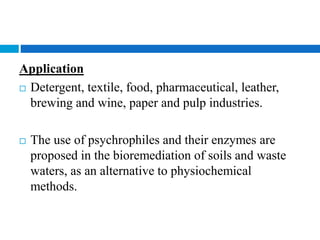Psychrophile
- 1. PHYSIOLOGY OF ORGANISMS LIVING IN EXTREME ENVIRONMENTS- PSYCHROPHILE (CRYOPHILE) Ms Saajida Sultaana Mahusook
- 2. Extremophiles are organisms that can survive in extreme environmental conditions. Extremophiles include members of all three domains of life, i.e., bacteria, archaea, and eukarya. Although the molecular strategies employed for survival in such environments are still not fully clarified, it is known that these organisms have adapted biomolecules and peculiar biochemical pathways to adapt in extreme environments. They possess enzymes and proteins which remain catalytically active under extremes of temperature, salinity, pH, and solvent conditions.
- 3. Psychrophiles are cold- loving organisms that grow at temperature of 15° C or lower. Psychrotolerant organisms are able to grow at temperature close to the freezing point of water but fastest growth rate at above 20° C.
- 4. Habitat: Microorganisms are found inhabiting the low temperature environments of the Earth, including polar regions, glaciers, ocean deeps, snow covered regions, shallow subterranean regions, upper atmosphere, refrigerated appliances and on and in plants and animals inhabiting cold regions. Examples: Pseudomonas antarctica, Psychrobacter aquaticus
- 5. Adaptation Mechanism of Psychrophile Maintaining membrane fluidity- Unsaturated-cis- Fatty acid, Carotenoids- prevent freezing. Cold shock proteins (CSPs) & Cold acclimatization proteins (CAPs) are cold adaptive proteins present in psychrophiles. These small proteins bind to RNA and preserve its single-stranded conformation. Antifreeze proteins, Ice nucleating protein, and Compatible osmotic solutes- protect the cell from freezing.
- 6. Proteins have a higher content of α-helix relative to the β-sheets.This helps to maintain flexibility even at low temperatures. Trehalose and exopolysaccharides (EPSs)- plays an impoertant role in cryoprotection. It also prevent protein denaturation and aggregation.
- 7. Application Detergent, textile, food, pharmaceutical, leather, brewing and wine, paper and pulp industries. The use of psychrophiles and their enzymes are proposed in the bioremediation of soils and waste waters, as an alternative to physiochemical methods.
- 8. Reference: https://www.ncbi.nlm.nih.gov/pmc/articles/PMC41 87170/ https://pdfs.semanticscholar.org/afcb/e822c6154b9 95b5e625f53284f18125e4ca0.pdf https://www.slideshare.net/jyotimatolia/extremophi les-59367883
- 9. Thank You








